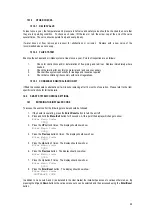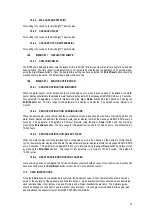
47
15.3
BURNER INSPECTION
The heat exchanger has a sight glass for inspection of the flame picture.
NOTE: If the appliance has been in recent operation, this area may be hot. Appropriate precautions should
be taken to prevent personal injury.
To check the flame picture at high and low fire, the following procedure should be followed:
1.
Place the water heater into service mode. This is done by depressing the small recessed button below the
Enter/Reset button for 5 seconds.
2.
The heater should shut down and relight.
3.
Depress the service button momentarily, this should ramp the water heater up to full rate.
4.
Check the flame condition.
5.
Depress the service button momentarily, this should ramp the water heater down to low rate.
6.
Check the flame condition.
7.
Press and hold the service button for 5 seconds to take the unit out of service mode.
15.4
BURNER REMOVAL
If it has been determined that the flame picture is unacceptable, the burner can be removed and cleaned using the
following procedure:
1.
Isolate the electrical and gas supplies to the heater.
2.
Allow the boiler to cool down.
3.
Disconnect the wiring connections to the ignition electrode.
4.
Disconnect the power and control connection leads and earthing wire from the combustion fan.
5.
Apply a suitable release oil to the 6 studs around the edge of burner door.
6.
Remove the 6 retaining nuts around the edge of the burner door.
NOTE: Once loosened, the nuts should be removed by hand. If any of the nuts seize, the nut should gently
be re-tightened and additional release oil used.
7.
Withdraw the heat exchanger front plate and burner assembly from the heat exchanger complete with the
combustion fan.
8.
With the burner assembly away from the boiler, the burner can be gently cleaned with the brush attachment
of a vacuum cleaner.
The reassembly procedure is the reverse of the above taking care to ensure that the for the heat exchanger front
plate sealing gasket, the combustion fan connection gasket, the burner door insulation and the combustion chamber
rear wall insulation are in good condition or are replaced as necessary.
NOTE: PARTICULAR ATTENTION SHOULD BE PAID TO THE COMBUSTION CHAMBER REAR WALL
INSULATION. IF ANY DETERIORATION IN THE INSULATING MATERIAL IS NOTED, THE
INSULATION PANEL MUST BE REPLACED.
15.5
CLEANING THE HEAT EXCHANGER
To clean the heat exchanger, the following procedure should be carried out:
1.
Remove the burners as above.
2.
Use a vacuum cleaner to remove any accumulation on the heating surfaces.
3.
Inspect the heat exchanger to ensure that the 1 mm flueway is clear between all coils.
4.
If any debris is still present, brush the heat exchanger with a non-metallic brush taking care not to damage
the insulation panel on the rear wall of the heat exchanger.
NOTE: A kit of components to aid with cleaning the heat exchanger is available from Lochinvar Limited. For
models EKW45CE – EKW115CE use part number KIT30063, for models EKW145CE – EKW235CE use
part number KIT30064.
NOTE: It is very important to inspect and remove all deposits from the heat exchanger. If all deposits
cannot be removed from the heat exchanger, contact Lochinvar Limited for further guidance.
5.
Once the heat exchanger has been brushed it should be rinsed with fresh water to remove all residues.
6.
Remove the condensate water trap and clean out any debris.






































